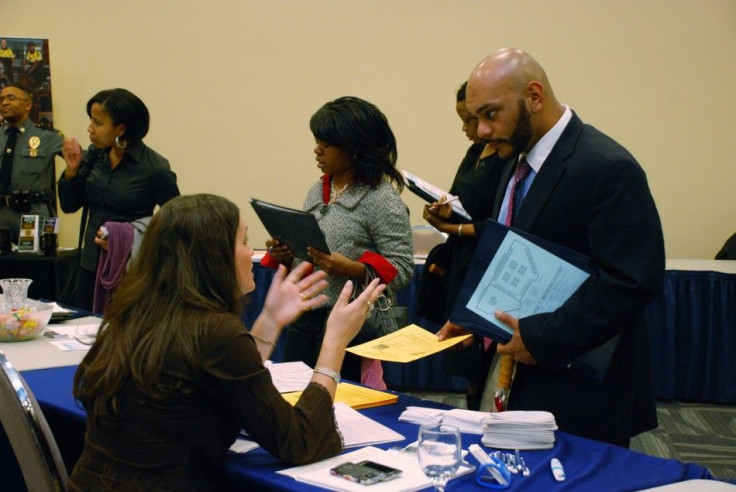U.S. Economy Added 117,000 Jobs in July: Better Than Expected
Analysis

The U.S. economy added 117,000 jobs in July, the U.S. Labor Department announced Friday -- well above the Bloomberg consensus estimate of 75,000.
Also, the nation's unemployment rate dipped to 9.1 percent from 9.2 percent. The better-than-expected July jobs report is qualified somewhat by the fact that 193,000 adults dropped out of the workforce, which means they're no longer longer officially counted as "unemployed."
In July, factories added 24,000 jobs and service providers added 75,000, but the government continued to shed jobs, losing 37,000 in July.
The bottom line regarding the condition of the U.S. job market, as of Aug. 2011? The jobs report was a pleasant surprise, but it probably will not eliminate concern that the U.S. economy will enter a double-dip recession. The U.S. economy is growing too slowly and is not creating anywhere near enough jobs to meet the needs of all Americans looking for work.
The U.S. economy has to create about 100,000 to 125,000 net new jobs per month, just to keep the unemployment rate from rising. Further, to substantially lower the unemployment rate, the economy has to create about 200,000 to 250,000 new jobs per month.
July's jobs report also occurs amid concern of "contagion" in Europe's credit markets. Institutional investors, concerned about bad bonds in Portugal and Italy, have been pushing up interest rates in those two debt-plagued countries, as they did to Greece and Ireland earlier in the financial crisis.
That contagion sparked a stock market sell-off Thursday in Europe and the U.S., with the Dow Jones Industrial Average plunging more about 513 points to 11,383. Analysts expected volatile trading conditions to persist until Europe's government debt problem is address satisfactorily by policy makers.
The impact on the U.S.? The so-called "bond vigilantes" -- a term coined by economist Ed Yardeni -- may turn their sights on the U.S. Treasury bonds, and other U.S. bonds, and if they do, they could push up U.S. interest rates as well, making it more costly for businesses and consumers to borrow. That would further complicate Fed Chair Bernanke's effort to rev-up the U.S. economy.
Difficult Decision for the Fed
Further, the July report does not eliminate what will likely be a more-complicated monetary decision for Fed Chair Ben Bernanke: he's already ended the second stage of the Fed's quantitative easing program, or QE2.
A lack of momentum in the economy may give doves on the Fed ammunition to recommend additional unconventional monetary tactics to stimulate the economy possibly in the form of third quantitative easing, QE3.
However, hawks on the committee, fearing another rise in inflation, will probably oppose them. That creates a challenging problem for Bernanke: how to get the economy moving again to create jobs, but not risk an uptick in inflation.
U.S. Has a 'Jobs Deficit'
What's more, although Congress, with the U.S. debt deal, took its first strides toward ending the budget deficit, the reality is an equally-weighty problem exists: the jobs deficit.
The nation is the midst of its greatest "job deficit" since the 1930s. The Economic Policy Institute, a liberal Washington, D.C.-based think tank says the United States is short a staggering seven million jobs.
In other words, the U.S. economy has to add seven million jobs, just to return the workforce to a level at the start of the recession, in December 2007.
Also, to keep up with population growth, the economy would have to add 11.1 million new jobs to restore the nation to the pre-recession unemployment level of five percent in December 2007.
To put that in perspective, if the U.S. economy added 300,000 new jobs per month, it would take roughly 37 months to return the nation to that five percent unemployment rate. During this recovery, the economy has created less than 200,000 new jobs per month.
Finally, the two-year, tepid U.S. recovery -- if the sub-par job growth trend persists -- will extract a political price on President Barack Obama. That's because historically, even though the President does not "control" the economy, the American people give him the credit for a strong economy at election time, and the blame if economy isn't performing well.
And historically, unemployment has be a key barometer for voters.
In short, the U.S. has to find a way to create many more jobs - for the good of all involved - investors, job seekers, and President Obama.
Political/Economic Analysis: A pleasant July jobs report, one that may help calm U.S. stock markets. Still, to generate the 200,000 to 250,000 new jobs per month that the nation needs to substantially lower the unemployment rate, the U.S. economy needs grow at a three percent rate or better. Right now, GDP growth is below two percent. Hence the mission is obvious: ways must be found -- fiscal/monetary, public and private -- to rev-up the economy and increase job growth. It's the foundation for the nation's well-being, along with corporate revenue growth and earnings growth
© Copyright IBTimes 2024. All rights reserved.





















